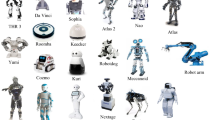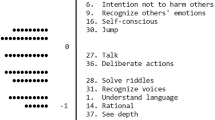Abstract
This study emphasizes the need for standardized measurement tools for human robot interaction (HRI). If we are to make progress in this field then we must be able to compare the results from different studies. A literature review has been performed on the measurements of five key concepts in HRI: anthropomorphism, animacy, likeability, perceived intelligence, and perceived safety. The results have been distilled into five consistent questionnaires using semantic differential scales. We report reliability and validity indicators based on several empirical studies that used these questionnaires. It is our hope that these questionnaires can be used by robot developers to monitor their progress. Psychologists are invited to further develop the questionnaires by adding new concepts, and to conduct further validations where it appears necessary.
Article PDF
Similar content being viewed by others
References
Sony (1999) Aibo, vol 1999
Breemen A, Yan X, Meerbeek B (2005) iCat: an animated user-interface robot with personality. In: Fourth international conference on autonomous agents & multi agent systems, Utrecht
Bartneck C, Rauterberg M (2007) HCI reality—an unreal tournament. Int J Hum Comput Stud 65:737–743
Kiesler S, Goetz J (2002) Mental models of robotic assistants. In: CHI’02 extended abstracts on Human factors in computing systems, Minneapolis, Minnesota, USA
Fink A (2003) The survey kit, 2nd edn. Sage, Thousand Oaks
Kooijmans T, Kanda T, Bartneck C, Ishiguro H, Hagita N (2007) Accelerating robot development through integral analysis of human-robot interaction. IEEE Trans Robot 23:1001–1012
Dawis RV (1987) Scale construction. J Counsel Psychol 34:481–489
Lessiter J, Freeman J, Keogh E, Davidoff J (2001) A cross-media presence questionnaire: The itc sense of presence inventory. Presence 10:282–297
Fong T, Nourbakhsh I, Dautenhahn K (2003) A survey of socially interactive robots. Robot Auton Syst 42:143–166
Bartneck C, Forlizzi J (2004) A design-centred framework for social human-robot interaction. In: Ro-Man2004, Kurashiki, pp 591–594
Dautenhahn K (2007) Socially intelligent robots: dimensions of human–robot interaction. Philos Trans R Soc B Biol Sci 362:679–704
Chalmers AF (1999) What is this thing called science? 3rd edn. Hackett, Indianapolis
Likert R (1932) A technique for the measurement of attitudes. Arch Psychol 140:1–55
Osgood CE, Suci GJ, Tannenbaum PH (1957) The measurements of meaning. University of Illinois Press, Champaign
Friborg O, Martinussen M, Rosenvinge JH (2006) Likert-based vs. semantic differential-based scorings of positive psychological constructs: A psychometric comparison of two versions of a scale measuring resilience. Pers Individ Differ 40:873–884
Powers A, Kiesler S (2006) The advisor robot: tracing people’s mental model from a robot’s physical attributes. In: 1st ACM SIGCHI/SIGART conference on Human-robot interaction, Salt Lake City, Utah, USA
Nunnally JC (1978) Psychometric theory, 2nd edn. McGraw-Hill, New York
Ishiguro H (2005) Android Science—Towards a new cross-interdisciplinary framework. In: CogSci workshop towards social mechanisms of android science, Stresa, pp 1–6
Minato T, Shimada M, Itakura S, Lee K, Ishiguro H (2005) Does gaze reveal the human likeness of an android? In: 4th IEEE international conference on development and learning, Osaka
MacDorman KF (2006) Subjective ratings of robot video clips for human likeness, familiarity, and eeriness: An exploration of the uncanny valley. In: ICCS/CogSci-2006 long symposium: toward social mechanisms of android science, Vancouver
Bartneck C, Kanda T, Ishiguro H, Hagita N (2007) Is the uncanny valley an uncanny cliff? In: 16th IEEE international symposium on robot and human interactive communication, RO-MAN 2007, Jeju, Korea, pp 368–373
Bartneck C, Kanda T, Ishiguro H, Hagita N (2008) My robotic doppelganger—a critical look at the uncanny valley theory. In: Interaction studies—social behaviour and communication in biological and artificial systems
Fogg BJ (2003) Persuasive technology: using computers to change what we think and do. Morgan Kaufmann, San Mateo
Heider F, Simmel M (1944) An experimental study of apparent behavior. Am J Psychol 57:243–249
Scholl B, Tremoulet PD (2000) Perceptual causality and animacy. Trends Cogn Sci 4:299–309
Parisi D, Schlesinger M (2002) Artificial life and Piaget. Cogn Dev 17:1301–1321
Blythe P, Miller GF, Todd PM (1999) How motion reveals intention: Categorizing social interactions. In: Gigerenzer G, Todd P (eds) Simple heuristics that make us smart. Oxford University Press, London, pp 257–285
Turkle S (1998) Cyborg babies and cy-dough-plasm: ideas about life in the culture of simulation. In: Davis-Floyd R, Dumit J (eds) Cyborg babies: from techno-sex to techno-tots. Routledge, New York, pp 317–329
Kahn P, Ishiguro H, Friedman B, Kanda T (2006) What is a human?—Toward psychological benchmarks in the field of human-robot interaction. In: The 15th IEEE international symposium on robot and human interactive communication, ROMAN 2006, Salt Lake City, pp 364–371
Calverley DJ (2005) Toward a method for determining the legal status of a conscious machine. In: AISB 2005 symposium on next generation approaches to machine consciousness: imagination, development, intersubjectivity, and embodiment, Hatfield
Calverley DJ (2006) Android science and animal rights, does an analogy exist? Connect Sci 18:403–417
Zykov V, Mytilinaios E, Adams B, Lipson H (2005) Self-reproducing machines. Nature 435:163–164
Tremoulet PD, Feldman J (2000) Perception of animacy from the motion of a single object. Perception 29:943–951
McAleer P, Mazzarino B, Volpe G, Camurri A, Patterson H, Pollick F (2004) Perceiving animacy and arousal in transformed displays of human interaction. J Vis 4:230–230
Lee KM, Park N, Song H (2005) Can a robot be perceived as a developing creature? Hum Commun Res 31:538–563
Bartneck C, Kanda T, Mubin O, Mahmud AA (2007) The perception of animacy and intelligence based on a robot’s embodiment. In: Humanoids 2007, Pittsburgh
Clark N, Rutter D (1985) Social categorization, visual cues and social judgments. Eur J Soc Psychol 15:105–119
Robbins T, DeNisi A (1994) A closer look at interpersonal affect as a distinct influence on cognitive processing in performance evaluations. J Appl Psychol 79:341–353
Berg JH, Piner K (1990) Social relationships and the lack of social relationship. In: Duck W, Silver RC (eds) Personal relationships and social support. Sage, Thousand Oaks, pp 104–221
Nass C, Reeves B (1996) The media equation. SLI Publications/Cambridge University Press, Cambridge
Monahan JL (1998) I don’t know it but I like you—the influence of non-conscious affect on person perception. Hum Commun Res 24:480–500
Burgoon JK, Hale JL (1987) Validation and measurement of the fundamental themes for relational communication. Commun Monogr 54:19–41
Dreyfus HL, Dreyfus SE (1992) What computers still can’t do: a critique of artificial reason. MIT Press, Cambridge
Dreyfus HL, Dreyfus SE, Athanasiou T (1986) Mind over machine: the power of human intuition and expertise in the era of the computer. Free Press, New York
Weizenbaum J (1976) Computer power and human reason: from judgment to calculation. Freeman, San Francisco
Searle JR (1980) Minds, brains and programs. Behav Brain Sci 3:417–457
Koda T (1996) Agents with faces: a study on the effect of personification of software agents. MIT Media Lab, Cambridge
Warner RM, Sugarman DB (1996) Attributes of personality based on physical appearance, speech, and handwriting. J Pers Soc Psychol 50:792–799
Parise S, Kiesler S, Sproull LD, Waters K (1996) My partner is a real dog: cooperation with social agents. In: 1996 ACM conference on computer supported cooperative work, Boston, Massachusetts, United States, pp 399–408
Kiesler S, Sproull L, Waters K (1996) A prisoner’s dilemma experiment on cooperation with people and human-like computers. J Pers Soc Psychol 70:47–65
Bartneck C, Verbunt M, Mubin O, Mahmud AA (2007) To kill a mockingbird robot. In: 2nd ACM/IEEE international conference on human-robot interaction, Washington DC, pp 81–87
American National Standards Institute (1999) RIA/ANSI R15.06—1999 American national standard for industrial robots and robot systems—safety requirements. American National Standards Institute, New York
Yamada Y, Hirasawa Y, Huang S, Umetani Y, Suita K (1997) Human-robot contact in the safeguarding space. In: IEEE/ASME transactions on mechatronics, vol 2, pp 230–236
Yamada Y, Yamamoto T, Morizono T, Umetani Y (1999) FTA-based issues on securing human safety in a human/robot coexistence system. In: IEEE international conference on systems, man, and cybernetics, 1999. IEEE SMC’99 conference proceedings, vol 2, pp 1058–1063
Bicchi A, Rizzini SL, Tonietti G (2001) Compliant design for intrinsic safety: general issues and preliminary design. In: 2001 IEEE/RSJ international conference on intelligent robots and systems, 2001. Proceedings, vol 4, pp 1864–1869
Bicchi A, Tonietti G (2004) Fast and “soft-arm” tactics [robot arm design]. IEEE Robot Autom Mag 11:22–33
Zinn M, Khatib O, Roth B, Salisbury JK (2002) Towards a human-centered intrinsically safe robotic manipulator. In: IARPIEEE/RAS joint workshop on technical challenges for dependable robots in human environments, Toulouse, France
Zinn M, Khatib O, Roth B (2004) A new actuation approach for human friendly robot design. In: 2004 IEEE international conference on robotics and automation. Proceedings. ICRA’04, vol 1, pp 249–254
Heinzmann J, Zelinsky A (1999) Building human-friendly robot systems. Int Symp Robot Res 305–312
Heinzmann J, Zelinsky A (2003) Quantitative safety guarantees for physical human-robot interaction. Int J Robot Res 22:479–504
Lew JY, Yung-Tsan J, Pasic H (2000) Interactive control of human/robot sharing same workspace. In: 2000 IEEE/RSJ international conference on intelligent robots and systems, 2000 (IROS 2000). Proceedings. pp 535–540
Zurada J, Wright AL, Graham JH (2001) A neuro-fuzzy approach for robot system safety. IEEE Trans Syst Man Cybern Part C Appl Rev 31:49–64
Traver VJ, del Pobil AP, Perez-Francisco M (2000) Making service robots human-safe. In: 2000 IEEE/RSJ international conference on intelligent robots and systems (IROS 2000). Proceedings, vol 1, pp 696–701
Ikuta K, Ishii H, Nokata M (2003) Safety evaluation method of design and control for human-care robots. Int J Robot Res 22:281–297
Haddadin S, Albu-Schaffer A, Hirzinger G (2007) Safe physical human–robot interaction: Measurements, analysis & new insights. In: International symposium on robotics research (ISRR2007), Hiroshima, Japan
Kulic D, Croft E (2005) Anxiety detection during human-robot interaction. In: IEEE international conference on intelligent robots and systems, Edmonton, Canada, pp 389–394
Rani P, Sarkar N, Smith CA, Kirby LD (2004) Anxiety detecting robotic system—towards implicit human-robot collaboration. Robotica 22:85–95
Rani P, Sims J, Brackin R, Sarkar N (2002) Online stress detection using phychophysiological signals for implicit human-robot cooperation. Robotica 20:673–685
Inoue K, Nonaka S, Ujiie Y, Takubo T, Arai T (2005) Comparison of human psychology for real and virtual mobile manipulators. In: IEEE international conference on robot and human interactive communication, pp 73–78
Wada K, Shibata T, Saito T, Tanie K (2004) Effects of robot-assisted activity for elderly people and nurses at a day service center. Proc IEEE 92:1780–1788
Koay KL, Walters ML, Dautenhahn K (2005) Methodological issues using a comfort level device in human-robot interactions. In: IEEE RO-MAN, pp 359–364
Sarkar N (2002) Psychophysiological control architecture for human-robot coordination—concepts and initial experiments. In: IEEE international conference on robotics and automation, Washington, DC, USA, pp 3719–3724
Nonaka S, Inoue K, Arai T, Mae Y (2004) Evaluation of human sense of security for coexisting robots using virtual reality. In: IEEE international conference on robotics and automation, New Orleans, LA, USA, pp 2770–2775
Kulic D, Croft E (2007) Physiological and subjective responses to articulated robot motion. Robotica 25:13–27
Kulic D, Croft E (2006) Estimating robot induced affective state using hidden Markov models. In: RO-MAN 2006—the 15th IEEE international symposium on robot and human interactive communication, Hatfield, pp 257–262
Kulic D, Croft EA (2007) Affective state estimation for human-robot interaction. IEEE Robot Trans 23:991–1000
Kulic D, Croft E (2005) Safe planning for human-robot interaction. J Robot Syst 22:383–396
Khatib O (1986) Real-time obstacle avoidance for manipulators and mobile robots. Int J Robot Res 5:90–98
Author information
Authors and Affiliations
Corresponding author
Rights and permissions
Open Access This is an open access article distributed under the terms of the Creative Commons Attribution Noncommercial License (https://creativecommons.org/licenses/by-nc/2.0), which permits any noncommercial use, distribution, and reproduction in any medium, provided the original author(s) and source are credited.
About this article
Cite this article
Bartneck, C., Kulić, D., Croft, E. et al. Measurement Instruments for the Anthropomorphism, Animacy, Likeability, Perceived Intelligence, and Perceived Safety of Robots. Int J of Soc Robotics 1, 71–81 (2009). https://doi.org/10.1007/s12369-008-0001-3
Received:
Accepted:
Published:
Issue Date:
DOI: https://doi.org/10.1007/s12369-008-0001-3




